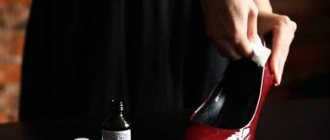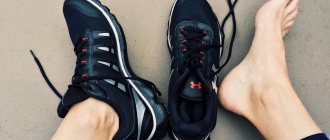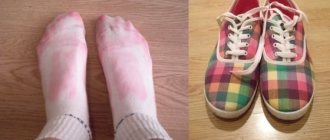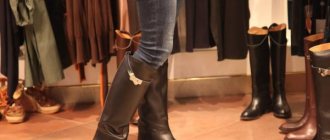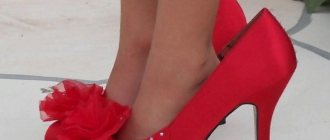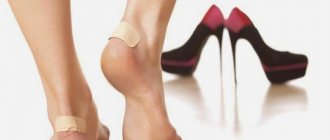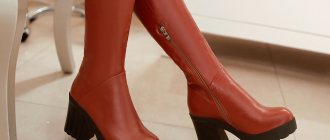Imagine that you ordered sneakers from a foreign online store, and they turned out to be too big. You’ve walked in them and understand that you’re uncomfortable: your leg is “dangling,” calluses have already appeared, and in general your legs get very tired in them. You'll probably be frustrated, not knowing what to do with them now. This problem can be solved in no time: just insert special tabs into the toe or heel of your shoes to reduce the size!
Everyone knows that if you wear shoes that are smaller, they will press and rub, causing pain, calluses and corns. However, if the shoes are too big, this is no less, if not more, harmful to the health of the feet. And that's why. In such shoes, with every step, the toes have to involuntarily bend in order to stay inside. The constant tension of the fingers causes spasms.
While the toes are trying hard to stay in the shoes, the rolling motion of the foot is disrupted. Because of this, when walking, the heel hits the surface harder and harder than when rolling smoothly. The load on the metatarsal joints also increases, and over time the middle part of the foot will “cramp”.
Shoes without lacing and Velcro are kept on the foot due to a tight fit to the foot. If the shoe size is too large, it does not fit tightly enough to the foot due to the presence of free space in it. In this case, the toes move towards the toe, and the heel begins to “dangle”.
In order not to harm your feet when wearing larger shoes, you need to “adjust” them to fit you. For this purpose, there are special “reducers” that can reduce shoes to one and a half sizes.
Full heel protection for sports shoes: minus 0.5 sizes
- How much shoes are reduced: 5 mm - 0.5 sizes
- How to use: paste into the heel area
- For what kind of shoes: sports shoes with a heel
You ordered excellent running sneakers from abroad, but made a mistake with the size and received shoes half a size too large. During the first run, it turned out that the heel in the new sneakers was “shaking.” Instead of exchanging the product for another and again waiting for the package to arrive, or trying to return the payment, you can simply glue these inserts into the heel of your sneakers. They will “eat up” empty space and will cushion you when playing sports.
Absorbent pads to reduce sports shoes by 3mm
- How much shoes are reduced: 3 mm
- How to use: stick to the inside of the heel of the shoe
- For which shoes: sports shoes with a heel, fastened to both textiles and suede
If the sneakers or sneakers do not fit you, the heel will “dangle” in them, and the heel of the shoe will rub the heel area. There is a solution - these are soft foam pads. They will reduce the size of your shoes and prevent them from rubbing your skin.
Primary requirements
The two main factors that determine the degree of slip are the material of the sole and the depth of the tread on it. The country of origin is important - it is advisable to choose one that experiences cold weather. Non-slip shoes provide good traction on the road, even when the road is icy or covered with snow. In winter, this possibility exists if there are soft tires.
Popular materials for making soles of winter and demi-season shoes and their properties:
- Thermoplastic elastomer. One of the most stable types, combining the qualities of thermoplastics and vulcanized rubber. It has strength, flexibility, frost resistance, and wear resistance. It retains its properties at temperatures down to -45 °C. Advantages: lightness, long service life, low cost.
- Thermopolyurethane. This is a polymer material. The sole made from it looks modern and has a number of advantages: wear resistance due to its high density, resistance to bending and abrasion, frost resistance at temperatures down to -50 ° C. It has good grip on the road surface, which virtually eliminates slipping. A disadvantage is the low degree of bendability.
An important rule for choosing non-slip shoes is to carefully study the tread. The main requirement for it is sufficient relief depth
A pattern with different directions is welcome, since only transverse or diagonal stripes will not provide complete slip protection. It is good if the teeth of the sole are arranged crosswise. A combination is possible when one part is made in the form of round protrusions, and the second consists of strips.
Thermoplastic elastomer
Thermopolyurethane
Deep outsole tread
Drawing with different directions
The teeth of the sole are arranged crosswise
Super-absorbent inserts in the toe of sports shoes: minus 1 size
- How much shoes are reduced: 1 size
- How to use: insert into the toe of the shoe
- For what kind of shoes: any closed-toe shoes, even tapered toes
Did the store mistakenly sell you a size too many sneakers? Dont be upset! Just place these inserts in the toe part of the shoe, and then the foot will stop sliding into the toe of the sneaker, and the heel will stop “dangling.”
Repair shops
If the shoes are too big, what should I do? Of course, go to a workshop where specialists can fit the shoes you bring to the desired size in a short time. This method is suitable for expensive shoes, because the service has a fairly high price. It is not profitable to customize cheap models.
Workshops have existed since ancient times. Previously, there were no shoe stores, and all shoes were made to order. Craftsmen sewed individual models and repaired shoes. Such people know all the secrets of how to make sure that shoes do not fly off fragile women’s legs.
Set for dress shoes “toe + heel”: minus 1.5 sizes
- How much shoes are reduced: 0.5-1.5 sizes
- How to use: put silicone half-socks on your toes, glue the insert into the heel of the shoe
- For which shoes: Dress shoes with a closed toe heel
If your favorite leather shoes have worn out and started to fall off your feet, don’t rush to say goodbye to them. This set can help you. Silicone socks, along with an insert in the heel of the shoe, will reduce the shoe by an entire size, and you can continue to wear it.
Inserts in dress shoes without slipping in stockings: minus 3-4 mm
- How much shoes are reduced: 3-4 mm
- How to use: stick to the inside of the heel of the shoe
- For which shoes: shoes with a heel and a smooth inner coating
Force majeure is an unacceptable phenomenon at important events. Imagine that when preparing for a wedding, anniversary or graduation, you were in a hurry and bought a little more shoes than you needed. You don’t have to drop everything and rush to the store to exchange a pair of shoes. It is enough to glue these tabs into the heel, and you can continue preparing for the celebration.
Elastic inserts with adjustable thickness in the toe of dress shoes: minus 1-2 sizes
- How much shoes are reduced: 1-2 sizes
- How to use: insert into the toe of the shoe
- For what kind of shoes: any closed-toe shoes, even tapered toes
The thickness of these inserts can be adjusted by inserting and removing internal elements. Therefore, they will save you if your feet swell in the evening and suffer in shoes that were just right for you in the morning. The products are very easy to slide in and out of your shoes, so you won't have any trouble removing them from your sock when you feel like there's almost no space left.
Advice on how to choose shoes
We go to the store to buy a new pair in a good mood on our day off. Having an attitude towards this matter will help you approach your choice with patience. In the morning we will plan the number of shoe stores that we may have to visit.
You need to be prepared for the fact that nothing will suit you in the first boutique. To make the search less tiring, lighten it up with a cup of coffee in the cafeteria or watching a movie in the cinema.
- You need to choose shoes in the middle of the day. Trying on after a work shift threatens that in the morning the boots will be too big, since the legs are swollen in the evening, and buying in the morning can have the opposite effect.
- Your feet will be comfortable in boots if you can move your toes.
- We put on a new pair and walk on a hard surface that is close to real conditions, listening to the sensations in our feet.
- Natural materials: leather, suede have the property of stretching when worn. If the leg is free, after a short time it will be very free.
We bought good quality shoes, don’t forget to properly care for and store them. We use protective creams against water and frost. Dry your boots away from hot appliances. Before putting away the autumn shoes for winter storage, we will wash them, clean them with shoe polish, stuff them with paper, pack them in a box, and put them on the mezzanine.
Soft protectors to reduce shoe instep by 2-3 mm
- How much does the instep of shoes decrease: 2-3 mm
- How to use: Wear on the forefoot
- For which shoes: open-toe shoes
Have you seen this picture: a girl walking along the sidewalk in open-toe shoes, and her toes “slap” on the asphalt? To avoid repeating this mistake, wear these protectors with open-toed shoes. Dense silicone will fix the foot in the toe part of the shoe and will not allow the toes to “fall out” out.
To avoid repeating this mistake, wear these protectors with open-toed shoes. Dense silicone will fix the foot in the toe part of the shoe and will not allow the toes to “fall out” out.
Orthopedic pads for dress shoes “minus 1 size”
- How much shoes are reduced: 1 size
- How to use: paste into shoes under the forefoot
- For which shoes: open-toe shoes
These pads are not put on the foot, but are placed under the sole of the toe. You can't even see them with your feet! They also seem to support the foot from below and prevent it from slipping forward, which means that in shoes with an open toe your toes will not “pop out” out.
What to do if the boots are big?
If your boots are a little big, use this life hack from professional football players. Wet them from the inside with warm water and go for a workout. You should run in wet boots for 10 to 25 minutes, but take precautions and do not use this advice during the cold season. This method is suitable for any shoes: both leather and artificial.
Some people advise using boiling water, but it is better not to do this. It will not harm the appearance, but the glue will not withstand high temperatures. Therefore, hold the boots for 5-7 minutes under hot tap water with the part that you want to make smaller (most often this is the sock). This method not only changes the size, but also makes the fabric a little softer.
Massage half-insoles to reduce the instep of dress shoes by 3 mm
- How much shoes are reduced: 3 mm
- How to use: Place under the forefoot
- For which shoes: open-toe shoes
In open shoes, and in particular in sandals, leather straps and constrictions can stretch during wear. Then the foot begins to “fall” forward and slide off the sole when walking. These half insoles will help you prevent this from happening. They will reduce the instep of the shoe by 3 mm and fix the foot in it.
Fabric socks to reduce open shoes by 2-3 mm, with fixation on the foot
- How much shoes are reduced: 2-3 mm
- How to use: Wear on the forefoot
- For which shoes: open-toe shoes
Have you ever worn sandals in hot weather? If so, then you will remember how a wet foot “wobbles” along the sole of a shoe. These socks will secure your foot, because they have a non-slip coating and a thick pad that will lift your foot and prevent it from “squeezing” between the strap and the insole. And they won’t fall off your feet or slip out, because they have an invisible but reliable fastening.
Basic cleaning rules
Regardless of which shoes have been damaged by glue, there are a number of general rules that will help preserve a damaged pair, and will also allow you to most effectively cope with this type of contamination:
- Firstly, any shoes should be cleaned as quickly as possible from the moment they become dirty. Removing glue that has not yet dried is much easier and safer for the surface.
- Secondly, most cleaning products are quite caustic and have a strong chemical smell. It is recommended to carry out all work to remove contamination with rubber gloves; you should also wear a respirator and ensure maximum ventilation of the room.
- Thirdly, when using any product, even a specialized one, you should not start removing traces of glue immediately, but test the selected composition on the most inconspicuous area. After the trial procedure, it is advisable to wait about 20-30 minutes and, if there is no change in the color or texture of the material, you can proceed to the main procedure.
- Fourthly, a specialized product can only be used on the material for which it is intended. A product for natural leather can easily ruin artificial leather and vice versa. To avoid such situations, you should carefully study the instructions and purpose of the purchased product.
